- Home
- Life Science Research
- Metabolomics
- Identification and confirmation of potential markers in rose and sunflower leaf extracts
Identification and confirmation of potential markers in rose and sunflower leaf extracts
Using the Accurate Mass Metabolite Spectral Library and TripleTOF® 6600 System
Jeffrey D. Miller1, Cyrus Papan2, Iris Klaiber3, Baljit K. Ubhi1 and Jens Pfannstiel3
1SCIEX, USA, 2SCIEX, Germany, 3Universität Hohenheim, Stuttgart, Germany
Abstract
Components of leaves and petals from plants have long been used in traditional medicine due to the various endogenous metabolites. Using mass spectrometry to study plant components the ability to both identify and quantify the components and find key differences. SWATH® Acquisition allows collection of MS/MS of all precursors meaning no missing data when compared to traditional IDA workflows. Here two data processing approaches were explored for analyzing SWATH acquisition data, using XCMSPlus for feature profiling and then Accurate Mass Metabolite Spectral Library with SCIEX OS Software or MasterView™ Software for targeted confirmation.
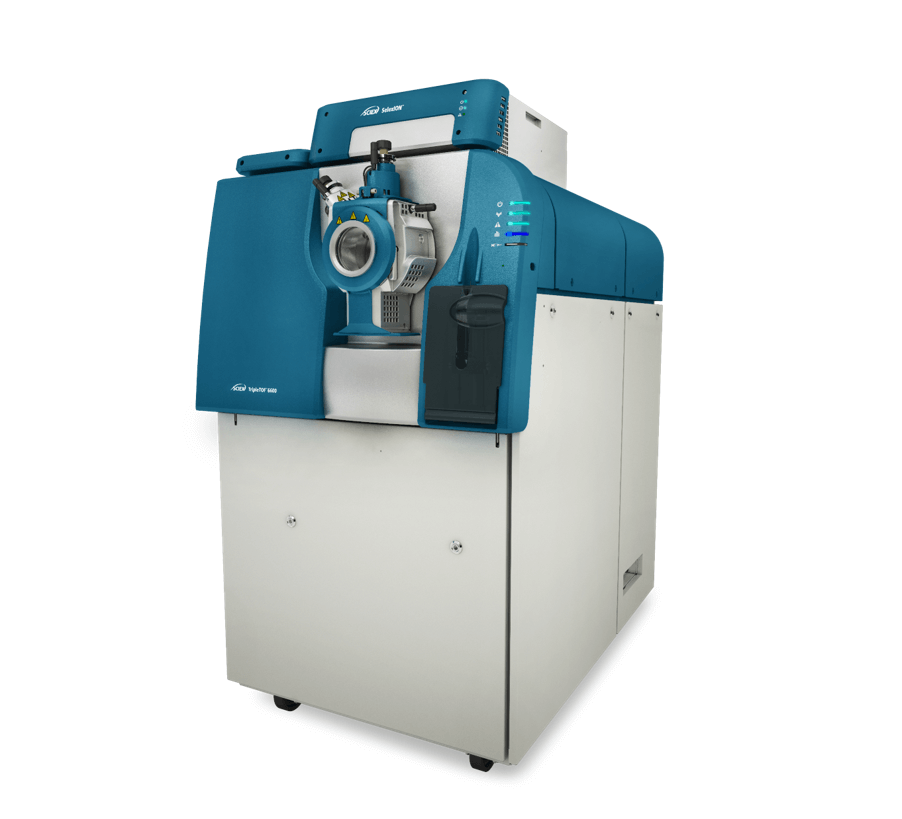
Introduction
Leaves and petals of plants such as rose and sunflowers have long been used for medicinal and aesthetic purposes around the world. Recently, investigators found that phenolic antioxidants especially those levels present in rose petal extracts of deep color (intense red to mauve) may be responsible for decreasing oxidative stress which plays a significant role in many metabolic diseases, thus justifying their use in traditional medicines.1 In addition, sunflower leaf tea is used in traditional medicine to reduce high fevers and has also been found to have astringent properties. Sunflower leaf poultice may be used on snakebites and insect bites. The leaves are diuretic and expectorant, as are the seeds, so determining what compounds are contributing to the activity and which metabolic pathways they belong to is of interest to many scientists. High resolution, accurate mass systems are the mass spectrometers of choice for global metabolomics applications as they employ a high degree of selectivity over nominal mass systems.
Unbiased targeted profiling on TripleTOF® Systems allows for the collection of MS and MS/MS data in a single-injection workflow. This discovery data can be searched with a targeted list of metabolites, from many chemical classes, pathways and species. Metabolite identification with a high resolution, accurate mass MS/MS library ensures increased confidence in assignment and purity scores of unknowns from a discovery experiment. Recently, a metabolite library has been developed to facilitate this process.2
Here, a study was performed to see if three separate rose leaf extracts and sunflower leaf extracts would produce variances in their profiles in comparison to one another and identify compounds associated with these changes perhaps leading to metabolic pathways for further investigation. Results illustrate the power of the technology as well as the software to drive the data processing and metabolite identification.
Figure 1. Workflow for metabolic profiling using the TripleTOF System. Data is taken from the TripleTOF 6600 System and processed through XCMSPlus software for feature finding. The metabolite identifications are confirmed by taking the metabolites of interest and passing them through the accurate mass metabolite library in SCIEX OS Software or MasterView™ Software.
Key features of workflow
- Unbiased profiling using the TripleTOF System allows for the collection of MS and MS/MS data in a single-injection workflow.
- Differential feature extraction using XCMSPlus software.
- Metabolite identification and confirmation using an accurate mass metabolite spectral library (AMMSL) ensures increased confidence in assignment and purity scores of unknowns from a discovery experiment.
Methods
Sample preparation: Extractions of rose petals from 3 different lots and an extraction of sunflower leaves were provided by University of Hohenheim, Stuttgart, Germany. An aliquot of all extracts was also combined into another “pooled” lot to serve as a quality control. The five different sample groups (3 x rose, 1 x sunflower and a pooled QC) were then injected in triplicate for analysis.
LC-MS acquisition: The TripleTOF 6600 System was used to acquire data in both positive and negative ion mode using SWATH® Acquisition and IDA (information dependent acquisition). The HPLC used was an Agilent 1290 (pump, column oven at 40 °C, autosampler). The column was a Phenomenex Kinetex XB-C18 column (2.6µm, 2.1 x 100mm) running at a flow rate of 300 µL/min. Injection volume of 5 µL was used. A linear gradient was formed using mobile phase A (H2O with 5mM NH4OAc) and B (acetonitrile with 5mM NH4OAc).
Workflow:
- Collection of MS and MS/MS data in a single-injection experiment.
- Examination of the sample batch to ensure reproducibility and integrity injection to injection.
- Detection of differential features between the different lots using multivariate statistical analysis in XCMSPlus Software.
- Generate a non-targeted “interest” list of candidates expressing the most significant differences, i.e., lowest p-values and highest log fold changes for investigation from XCMSPlus Software
- Confirm the differential features from XCMSPlus with the Accurate Mass Metabolite Spectral Library in SCIEX OS Software or MasterView Software for the presence of known metabolites. (In this study, compound standards were purchased and added to the existing AMMSL library (Phlorizin and Phloretin) to allow confirmation of these specific plant metabolites.)
Profiling of metabolite features
The data files were opened in SCIEX OS Software or PeakView® Software and the chromatograms examined for reproducibility and integrity, injection to injection (Figure 2). This is always good practice to QC the data this way before starting to process it to identify any issues encountered during sample collection.
Next the data was processed the using XCMSPlus Software3 for multivariate statistical analysis. Peaks are picked, aligned and differential features reported based on p-value significance. Figure 3 shows the Scores plot from a Principal Component Analysis, which shows the differences between the three rose lots and sunflowers extracts as well as the pooled QC’s. The “pooled” QC samples are shown at the center of the scores plot as expected since they are a composite of all samples. The replicate injections in each group also cluster together well this is a good indication that high quality data was collected for this study.
Figure 2. Stacked total ion chromatograms (TICs) of the negative mode plant data. Overlaid TICs highlight the injection to injection reproducibility across the batch. Retention time reproducibility had CV’s of <1.6%. |
Figure 3. Principle component analysis (PCA) in XCMSPlus Software. The different lots of plants are differentiated by their metabolite profiles. The PCA plot highlights that 49% of the variation in our dataset is being explained in the first principle component. PC2 explains another 17% of the variation (or difference) in our data. This is in fact true when you see that the biggest difference is left to right between the sunflower and rose extracts. The second biggest difference is between the three different rose lots.
The XCMSPlus feature table lists all of the differentiating features by p-values and or q-value (FDR adjusted p value). Clicking on any row in the feature table of the software, extracts the ion chromatogram on the right hand side (Figure 4). Results can be explored in detail using the interactive features.
Figure 4. Results table from XCMSPlus Software. The results table highlights the top 19 candidates with the lowest p-values from the positive mode data. Each row is a feature extracted from the data. Selecting a row such as #3 (grey highlight) displays the XIC’s from all samples for visual comparison. The light blue traces shown were the sunflower extracts, dark blue were the “pooled” sample traces.
MS/MS confirmation of target list
After exploration of the profiling data, the identities of each metabolite should next be confirmed using the high resolution MS/MS data collected in the same files. A differential feature list can be exported from XCMSPlus Software and imported into MasterView Software for ID confirmation using the Accurate Mass Metabolite Spectral Library.
Confirmation by MS/MS means higher confidence in the assigned metabolite. The top pane in Figure 5 shows the XIC of the highlighted row for Catechin. The center pane contains the report information and formulas, the bottom two panes show the library matches of MS and MS/MS spectra. Relative quantitative amounts of the compounds from the target list were easily reviewed and summarized. Table 1 shows that the rose extracts had high levels of Kaempferol, Quercetin, Catechin, Glutamic acid and L- Phenylalanine. Phlorizin (a flavonoid known to be present in apple and cherry), was used as an internal standard and was spiked into the rose leaf extracts at different concentrations. No Phlorizin was added to the sunflower extract; therefore it was not identified in this sample. Sunflower extracts showed high levels of Genistein in positive mode compared to lower levels in the rose extracts. The presence and relative amounts of several endogenous organic acids are also shown in Figure 5.
| Table 1. Summary of differential compounds between sunflower and rose extracts. |
Figure 5. Accurate Mass Metabolite Spectral Library (ASSML) to confirm the identities of detected differential features. Clicking on an entry in the table (Catechin) exposes further results to explore. The bottom left pane yields the isotopic pattern and accurate mass spectra with blue (experimental) overlaid upon the theoretical isotopic pattern (gray). The bottom right pane shows the library matched MS/MS spectra (blue experimental spectra and gray reflected library spectra). The top pane shows the Extracted Ion Chromatogram (XIC) MS data for Catechin.
Conclusions
Combining XCMSPlus and the Accurate Mass Metabolite Spectral Library was beneficial in confirmation of several antioxidants and endogenous metabolites present in both rose and sunflower leaf extracts. SWATH acquisition allows collection of MS/MS of all precursors meaning no missing data when compared to traditional IDA workflows.
References
- Cunja, V.; Mikulic-Petkovsek, M.; Stampar, F.; Schmitzer, V. (2014) Compound Identification of Selected Rose Species and Cultivars: an Insight to Petal and Leaf Phenolic Profiles, JASHS 139(2), 157-166.
- Accurate Mass Metabolite Spectral Library developed by Gerard Hopfgartner, Emmanuel Varesio, Tobias Bruderer, University of Geneva, Switzerland.
- Developed by Gary Siuzdak and colleagues at Scripps Research Institute, La Jolla, CA.
 Click to enlarge
Click to enlarge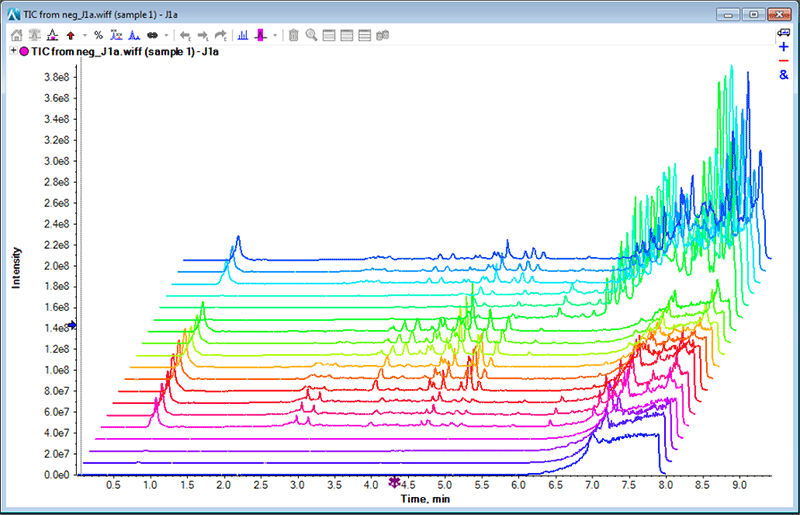 Click to enlarge
Click to enlarge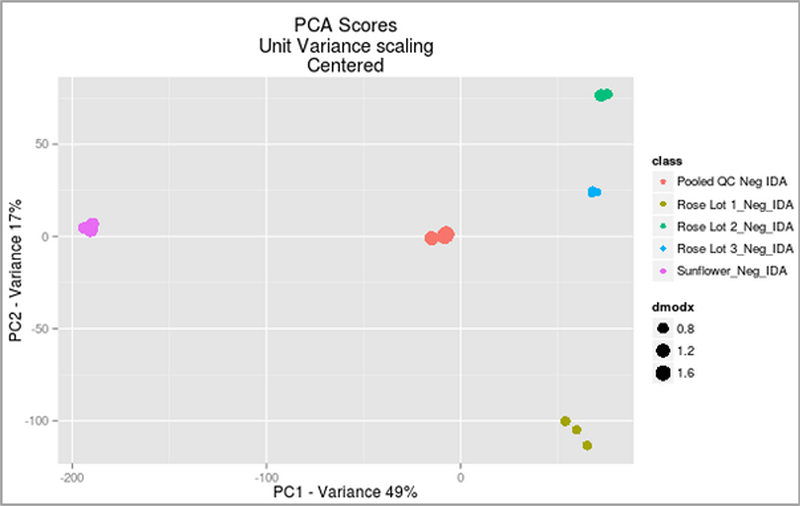 Click to enlarge
Click to enlarge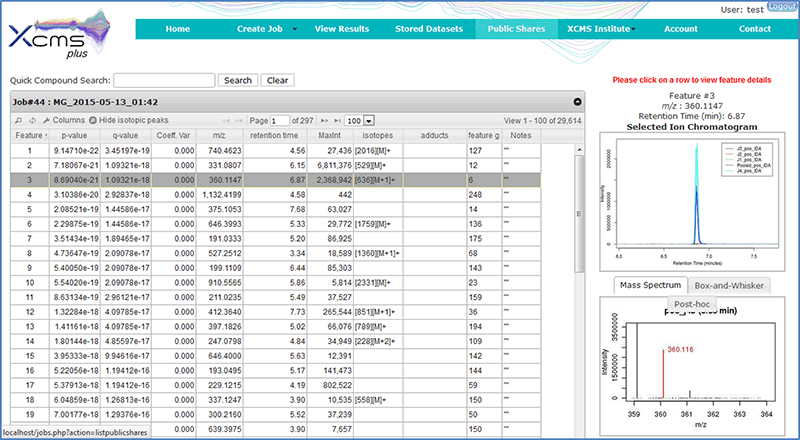 Click to enlarge
Click to enlarge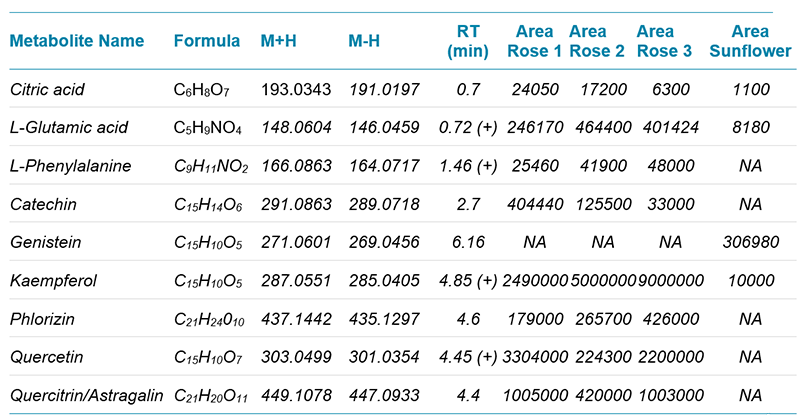 Click to enlarge
Click to enlarge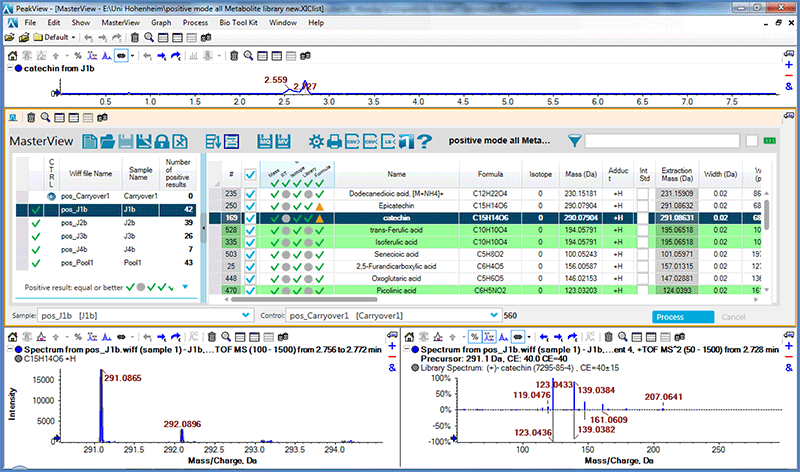 Click to enlarge
Click to enlarge